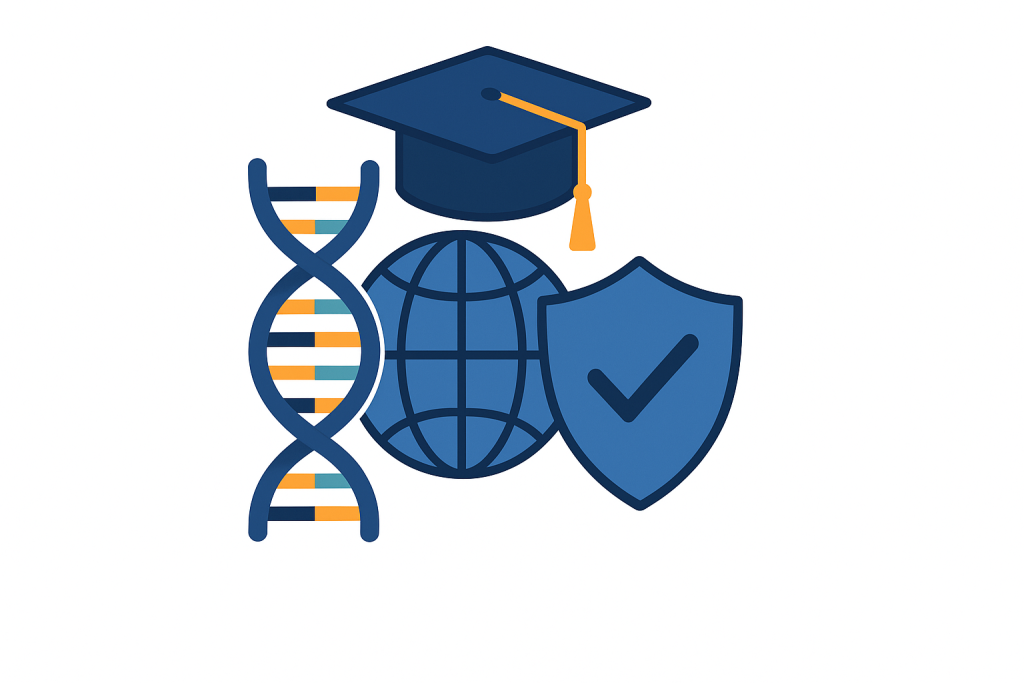The next generation won’t just study biology—they’ll build it. The question is: will they build it responsibly?
The Shift: From Learning Life to Programming It
Biology has entered the age of design.
Students today are no longer just observing cells under microscopes—they’re programming them. Synthetic biology, the fusion of biology and engineering, lets young scientists design organisms that produce materials, clean pollutants, or even generate energy.
This creative power is inspiring, but it also carries weight. When life becomes programmable, safety and ethics must become part of the curriculum, not an afterthought. Education is now the first line of biosecurity.
Why Education Defines Biosecurity
The future of safety isn’t in regulation—it’s in mindset.
As access to biotechnology grows, so does its reach beyond formal institutions. High school competitions, community bio-labs, and DIY science kits make biology accessible to anyone with curiosity and an internet connection.
That openness fuels innovation—but also introduces risk. A poorly handled experiment or misunderstood genetic tool could have unintended consequences. The solution isn’t to restrict access—it’s to teach responsibility alongside experimentation.
Every biology classroom, from secondary school to university, now serves as a biosecurity classroom too.
Three Pillars of Responsible Biotech Education
1. Safety Literacy
Knowing the rules before breaking new ground.
Before students learn how to edit genes, they should learn how to handle biological materials safely. This includes understanding biosafety levels, sterilization techniques, and containment procedures.
Even simple lab activities can reinforce habits that last a lifetime: labeling samples, using protective equipment, and respecting biological waste. When taught early, safety becomes second nature, not a barrier to creativity.
2. Ethical Literacy
Teaching the “should we?” alongside the “can we?”
Synthetic biology raises profound questions about the limits of human design. Should we create new species? Modify ecosystems? Patent life?
Schools and universities can cultivate ethical reasoning through case studies, debates, and collaborative discussions. Students should analyze real-world dilemmas—from gene editing in agriculture to DNA data privacy—and learn to see science as a moral practice, not just a technical one.
Ethical literacy ensures that innovation serves humanity rather than surprises it.
3. Security Awareness
Recognizing that biology can be misused—intentionally or not.
Students should understand that the same genetic tools used to cure disease could, in theory, be used to create harm. This isn’t about fear—it’s about foresight.
Introducing topics like dual-use research, synthetic DNA screening, and digital data protection teaches students to think like scientists and stewards. They learn to view security not as a restriction, but as part of responsible design.
Building Biosecurity into the Curriculum
Teaching safety doesn’t mean slowing down progress—it means ensuring it lasts.
Integrating biosecurity into science education can be simple and scalable:
- Classroom Modules: Introduce bioethics and lab safety in biology courses, even at the middle school level.
- Competitions and Camps: Programs like iGEM (International Genetically Engineered Machine) can include explicit safety and ethics challenges.
- Mentorship and Certification: Encourage students to complete biosafety certifications or internships in regulated labs.
- Digital Learning: Online courses can teach both the promise and pitfalls of biotechnology for global audiences.
This creates a generation of bio-literate citizens, not just biotechnologists—people who understand how biology, technology, and society intersect.
The Role of Educators and Parents
Guidance is as critical as access.
Parents and teachers don’t need to be scientists to promote responsible curiosity. Encouraging students to ask critical questions—“Where does this data go?” or “Who regulates this experiment?”—builds awareness and accountability.
Supporting science fairs, bio clubs, or school partnerships with local labs can empower young learners, while also reinforcing that science comes with shared responsibility.
Education should inspire confidence, not complacency.
Preparing for a Bio-Literate Future
Tomorrow’s breakthroughs will depend on how we teach today.
As synthetic biology becomes part of everyday life—embedded in medicine, food, and climate solutions—society will need people who understand both its potential and its pitfalls.
Teaching safety, ethics, and security early ensures that biotechnology evolves with intention, not by accident. The next generation won’t just inherit biology—they’ll reimagine it. It’s our job to give them the tools and values to do it wisely.
Conclusion: Responsibility as Innovation
Innovation without responsibility isn’t progress—it’s risk disguised as discovery.
The true test of our educational systems is whether they can produce not just brilliant scientists, but thoughtful ones.
Teaching safety in the age of synthetic biology is not about limiting imagination—it’s about ensuring that imagination builds a future we can all live with.


